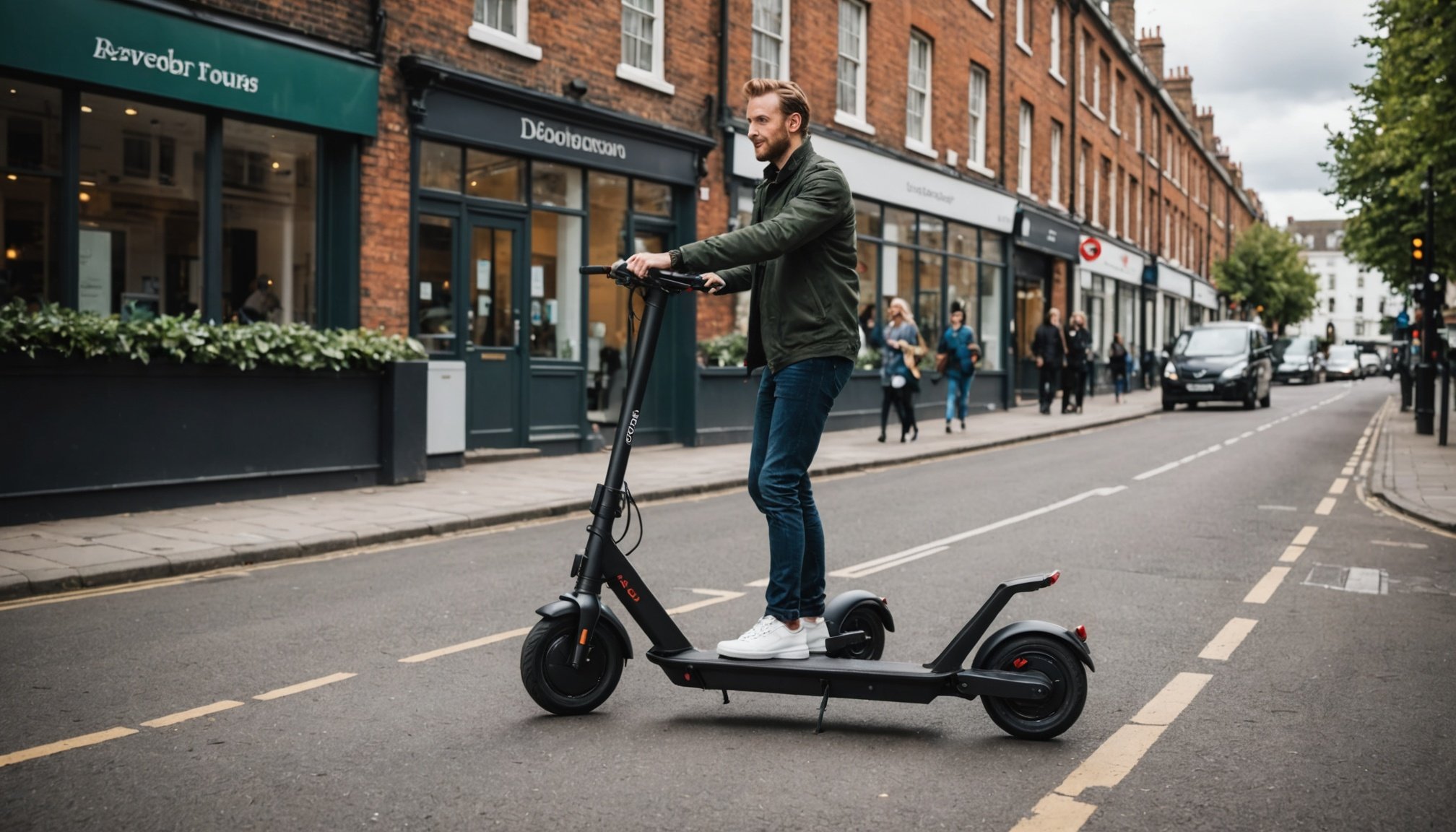Revolutionizing Urban Transport in the UK: Embracing Electric Scooters for Sustainable Mobility
The Rise of Electric Scooters in Urban Areas
In the bustling cities of the UK, a new wave of transportation is gaining momentum, promising to transform the way we navigate urban areas. Electric scooters, or e-scooters, have emerged as a viable, sustainable, and convenient alternative to traditional modes of transport. These sleek, eco-friendly vehicles are not just a fad; they are a significant step towards revolutionizing urban mobility.
Why E-Scooters?
E-scooters offer several benefits that make them an attractive option for urban dwellers. Here are a few key reasons why they are gaining popularity:
Have you seen this : Unveiling innovative developments in greenhouse gas emission monitoring across the uk
- Sustainability: E-scooters are electric, which means they produce zero emissions, contributing to a cleaner environment and helping to reduce the city’s carbon footprint.
- Convenience: They are perfect for short trips, connecting people to public transit and replacing short taxi rides or car journeys.
- Cost-Effective: E-scooters are often cheaper than traditional transportation methods, making them an economical choice for daily commutes.
- Ease of Use: With their lightweight design and simple operation, e-scooters are accessible to a wide range of users.
Regulatory Challenges and Solutions
While e-scooters hold great promise, their integration into urban transportation systems is not without its challenges. One of the most significant hurdles is the need for balanced regulation.
The Balance Between Regulation and Freedom
Cities like London are grappling with how to regulate e-scooters effectively. The key is to strike a balance between protecting citizens and attracting operators. Overregulation can stifle the market, while underregulation can lead to safety issues.
Also to discover : Unveiling cutting-edge sustainable consumer electronics trends in the uk
For instance, in London, the heavily regulated trial period for e-scooters has left operators struggling. Fredrik Hjelm, CEO of Voi, highlighted this issue in a letter to London’s Mayor, Sadiq Khan, stating that the regulations have made it difficult for operators to compete with unregulated providers[1].
To address this, cities are exploring more mindful and balanced regulatory approaches. Here are some strategies being considered:
- Vehicle Capacity Limits: Implementing caps on the number of vehicles only in areas where congestion is a problem. For example, Bergen in Norway has successfully used this approach to manage e-scooter traffic without hindering business[1].
- Geofencing Adjustments: Reducing the number of ‘go slow’ and ‘no go’ zones to improve the riding experience. In London, Transport for London (TfL) has eased geofencing rules to minimize sudden stops that could cause accidents[2][3].
- Safety Standards: Ensuring operators meet certain vehicle standards and introducing measures like parking tickets to encourage responsible use.
Easing Geofencing Rules for Enhanced Safety
Geofencing technology, which limits where and how fast e-scooters can operate, has been a contentious issue. While it is designed to enhance safety, it can also create hazards if not implemented carefully.
London’s Approach to Geofencing
In London, TfL has been working to refine the geofencing system. Helen Sharp, TfL’s e-scooter trial lead, explained that safety is at the core of their e-scooter trial and that they have reduced the number of ‘go slow’ and ‘no go’ areas to improve the experience for riders without impacting non-users[2][3].
Here are some key changes made to the geofencing rules in London:
- Reduced Restricted Areas: The number of areas where e-scooters are restricted has been reduced, making the riding experience smoother.
- Age Restrictions Eased: Riders aged 16 and over are now permitted to rent e-scooters, aligning with Department for Transport (DfT) guidance that requires at least a provisional driving licence[3].
- Incident Reporting: TfL receives weekly incident reports and has found that reducing geofencing has led to fewer safety incidents. For example, two boroughs that removed e-scooter geofences reported no safety incidents[3].
Industry Response and Future Directions
The e-scooter industry is keenly watching these regulatory developments and is actively engaging with authorities to shape the future of urban mobility.
Aligning Regulatory Standards
Operators like Voi are advocating for more aligned regulatory standards between e-scooters and e-bikes. James Bolton, Voi’s UK General Manager, emphasized the need for consistent regulation to unlock the full potential of e-scooters in London[3].
Here are some industry perspectives on the future of e-scooters:
- Consistent Regulation: Ensuring that e-scooters and e-bikes are regulated in a similar manner to create a level playing field.
- Expanding Services: Operators are looking to expand their services to more areas, making e-scooters a more viable option for longer trips.
- Technological Advancements: Integrating new technologies, such as improved geofencing and safety features, to enhance the user experience.
Practical Insights and Actionable Advice
For those considering using e-scooters or for cities looking to implement shared micromobility schemes, here are some practical insights and actionable advice:
For Users:
- Follow Safety Guidelines: Always wear protective gear, follow traffic rules, and park responsibly.
- Choose Reputable Operators: Opt for operators that adhere to safety standards and provide well-maintained vehicles.
- Be Mindful of Geofencing: Understand the geofencing rules in your area to avoid sudden stops or other safety hazards.
For Cities:
- Conduct Thorough Trials: Test different regulatory approaches to find the right balance between safety and market attractiveness.
- Engage with Operators: Collaborate with e-scooter operators to understand their needs and challenges.
- Monitor and Evaluate: Continuously monitor the performance of e-scooter schemes and make adjustments as necessary.
Comparative Analysis: E-Scooters vs. E-Bikes
To better understand the role of e-scooters in urban mobility, it’s useful to compare them with another popular micromobility option: e-bikes.
| Feature | E-Scooters | E-Bikes |
|---|---|---|
| Speed | Typically limited to 12.5mph (London) | Can reach higher speeds, often up to 15.5mph |
| Range | Generally shorter range, suitable for short trips | Longer range, suitable for both short and longer trips |
| Ease of Use | Lightweight, easy to maneuver | Requires more physical effort, but offers more stability |
| Cost | Often cheaper to rent | Can be more expensive to purchase or rent |
| Regulation | Subject to geofencing and specific zones | Less restrictive, but still subject to some regulations |
| Environmental Impact | Zero emissions, eco-friendly | Zero emissions, eco-friendly |
| Popularity | Growing, especially among younger users | Established, popular among a broader age group |
As the UK continues to embrace electric scooters as a sustainable mobility solution, it is clear that these vehicles are here to stay. By striking the right balance between regulation and freedom, cities can create an environment where e-scooters thrive, contributing to a more sustainable, efficient, and eco-friendly urban transportation system.
In the words of Fredrik Hjelm, “Micromobility is crucial to reduce dependency on cars and to increase sustainable and accessible forms of transport.” As we look to the future, it is evident that electric scooters will play a pivotal role in revolutionizing urban transport, making our cities cleaner, greener, and more connected.
Table: Key Statistics on E-Scooters in London
| Statistic | Detail |
|---|---|
| Number of E-Scooters | 4,425 currently available across 10 London boroughs[5] |
| Operators | Lime, Voi, Tier[2][3] |
| Maximum Speed | 12.5mph[2] |
| Geofencing Impact | Affects 15% of all e-scooter rides, with 40% of affected riders not taking another trip[3] |
| Age Restrictions | Riders must be 16 or older, with a provisional driving licence required[3] |
| Trial Areas | Operate in ten London boroughs, with restrictions in certain areas like Royal Parks and the South Bank[2][3] |
By embracing electric scooters and other micromobility solutions, the UK is paving the way for a more sustainable, efficient, and connected urban transportation system – a future where mobility is not just about getting from point A to point B, but about doing so in a way that benefits both the individual and the environment.
Infrastructure Requirements for Electric Scooters
Navigating city streets on an electric scooter requires specific infrastructure to ensure safety and efficiency. Urban planning for e-scooters is crucial to accommodate the increasing number of users and to integrate seamlessly with the existing transport networks.
Necessary Changes in Urban Infrastructure
To support sustainable transport networks, the development of dedicated lanes is essential. These lanes not only promote rider safety by reducing conflicts with motor vehicles but also streamline the flow of both scooters and bicycles through urban areas. Well-marked paths prioritize the presence of scooters, making urban environments more sustainable and efficient.
Importance of Dedicated Lanes and Parking
The creation of scooter parking solutions is pivotal. Without adequate parking, sidewalks may become cluttered, leading to pedestrian inconveniences. Strategic parking spots, close to popular destinations, can enhance accessibility and encourage more individuals to opt for scooters over cars, contributing to reduced congestion and pollution.
Integrating with Existing Transport
Integration with current transport frameworks and facilities ensures that the use of scooters enhances rather than disrupts city mobility. By positioning scooter stations near public transit hubs, it becomes easier for commuters to switch between different modes of transport seamlessly. As cities adapt, these measures will be vital in creating a cohesive, eco-friendly transit ecosystem.
Potential Challenges of Electric Scooter Adoption
Adopting electric scooters as a mainstream mode of transport comes with its own set of challenges. Public perception and acceptance of electric scooters play a crucial role. Many people question their sustainability and overall safety due to the scooter’s compact size and the dependency on individual responsibility for proper usage. This scepticism can pose a significant barrier to adoption.
Moreover, regulatory hurdles present another challenge. Legislation adjustments are necessary to accommodate the increasing use of electric scooters in urban environments. Currently, there is a lack of consistency in regulations across different regions, creating confusion and limiting scooter usage. Governments need to establish clear and cohesive guidelines to address rider safety, traffic rules, and parking provisions.
Sustainability issues also emerge with the use of lithium batteries. These batteries are vital for electric scooters but pose environmental concerns, especially in terms of disposal and maintenance. The potential waste from discarded batteries can negate the environmentally friendly image of electric scooters. It’s crucial to develop better recycling processes and standards to ensure that the adoption of electric scooters contributes positively to sustainability.
Recognising and addressing these barriers can lead to greater acceptance and a smoother integration of electric scooters into daily life.
Transforming Urban Mobility with Electric Scooters
Modern urban mobility faces a host of challenges in cities across the UK. Increased congestion, rising pollution levels, and limited parking spaces have pressured the need for sustainable transport solutions. These challenges have paved the way for the rise of electric scooters as a viable transport option.
Electric scooters are increasingly seen as a flexible solution to these urban mobility woes. They offer a compact, efficient mode of transport that seamlessly integrates into the daily transit fabric. Unlike traditional vehicles, electric scooters provide enhanced maneuverability in congested areas, making them ideal for short urban commutes.
The benefits of electric scooters highlight their role in reshaping urban transport. Firstly, they significantly reduce carbon emissions compared to cars, supporting environmental goals. Secondly, they alleviate traffic congestion by occupying less road space. Additionally, they require no parking space, offering a convenient “last-mile” solution that public transport often fails to cover.
Comparatively, electric scooters are cost-effective, both in terms of purchase price and ongoing maintenance. This makes them an appealing choice for both individuals and city planners seeking efficient mobility solutions. By understanding the advantages of electric scooters, urban areas can better address transport-related issues, improving overall city accessibility and livability.
Benefits of Electric Scooters
Riding electric scooters offers numerous advantages, both for individuals and the environment. One of the primary benefits of electric scooters is their contribution to sustainability. As a cleaner mode of transport, these scooters help in the reduction in carbon emissions, making them an eco-friendly alternative to traditional gasoline-powered vehicles. This reduction is crucial for combating climate change and improving urban air quality.
For both users and cities, electric scooters also present significant economic advantages. They are typically cheaper to operate and maintain than cars or motorcycles, offering a cost-effective mode of transportation. Cities benefit from reduced road wear and lower infrastructure maintenance costs due to fewer vehicles on the road.
Furthermore, electric scooters can play a role in alleviating traffic congestion, thereby offering health benefits. With less stop-and-go traffic, emissions decrease, contributing to better air quality and overall public health. Additionally, communities experience enhanced pedestrian safety and less noise pollution.
By addressing environmental, economic, and health aspects, electric scooters provide a holistic solution to urban transportation challenges. Their integration into daily commutes promotes a sustainable and efficient lifestyle, encouraging more people to adopt this versatile mode of travel.
Challenges of Integrating Electric Scooters
Integrating electric scooters into urban environments presents distinct challenges, especially concerning safety and infrastructure. One of the most pressing issues is the occurrence of accidents and common safety concerns. Statistics indicate that accidents involving electric scooters often occur due to their limited visibility and speed capabilities, compounded by inexperienced riders. This has led to increased pressure on municipal authorities to address public safety concerns.
Moreover, the existing urban infrastructure is frequently unprepared for the influx of electric scooters. Cities often lack dedicated lanes and parking spaces, resulting in scooters being left haphazardly on sidewalks, which can obstruct pedestrians and contribute to hazards. Effective integration requires careful planning in constructing ample scooter lanes and developing clear traffic rules tailored to scooters’ unique characteristics.
Public perception poses another significant hurdle. Many residents express concern over scooters’ potential to disrupt daily life, fearing an increase in accidents or inconvenience. Resistance often stems from a lack of familiarity with electric scooters and their benefits. Addressing these concerns head-on by educating the public and showcasing the environmental and convenience benefits of electric scooters could gradually shift perception, easing the transition towards a more scooter-friendly urban setting. Such measures are crucial for fostering acceptance and achieving safe, efficient electric scooter integration.
Case Studies: UK Cities Embracing Electric Scooters
Electric scooters are making waves across UK cities, with implementations transforming urban landscapes.
London: Pilot Programs and Outcomes
London has taken bold steps in integrating electric scooters through its pilot programs. These initiatives focus on safety and infrastructure, essential in the city’s bustling environment. The use of designated lanes and strict adherence to safety protocols has led to a reduction in traffic congestion and pollution.
Bristol: Innovations in Scooter Policies
Bristol stands out for its innovative approach to electric scooter policies. The city encourages community involvement in policy-making, fostering a sense of ownership and compliance among residents. This inclusive strategy results in smoother adoption and usage, translating into significant benefits for urban mobility.
Milton Keynes: Urban Design and Electric Mobility
Milton Keynes shines with its urban planning that supports electric mobility. The city’s commitment to wide cycle lanes and smart traffic management systems accommodates the growing number of scooter users. This foresight in urban design not only promotes electric mobility, but also enhances the quality of life by reducing travel times and environmental impact.
Across these cities, there’s a clear lesson: thoughtful implementation of electric scooter programs can transform urban life positively.
Regulatory Landscape for Electric Scooters
Navigating the electric scooter regulations can be as challenging as mastering the scooter itself. Understanding the current legislation in your country is crucial for safe and compliant usage. In the United Kingdom, electric scooters are predominantly classified as “powered transporters.” These are subject to the same laws as motor vehicles, meaning they cannot be used on pavements, cycle lanes, or public roads unless part of an approved trial.
When compared to other countries, the UK’s stance is notably stricter. For instance, in France, riders are allowed on roads with speed limits under 50 km/h and are required to wear high visibility clothing at night. Meanwhile, electric scooters in Germany are permitted on cycle paths and roads, but not on pavements. Differences in policy reflect varying approaches to safety and urban integration.
Looking ahead, changes in regulations may aim to better integrate scooters into public transport networks, reflecting the vehicle’s growing popularity. Compliance with evolving legislation will be crucial, potentially involving mandatory insurance or licensing as seen in some regions.
Understanding and adapting to these regulatory trends ensures not only the lawful use of electric scooters but also their safe coexistence with other traffic participants.
Environmental Impact of Electric Scooters
Electric scooters offer a promising path towards environmental sustainability by significantly reducing the carbon footprint associated with urban commuting. Unlike traditional vehicles relying on fossil fuels, electric scooters operate on clean energy, resulting in considerably lower emissions of greenhouse gases. This shift to green transportation directly supports urban sustainability initiatives aimed at reducing pollution levels in cities.
Assessment of electric scooters’ environmental footprint begins with their efficiency in energy use. Since they are designed for short urban trips, electric scooters consume less energy compared to cars. Additionally, they alleviate traffic congestion, further reducing overall emissions in city environments. Electric scooters serve as an example of how urban areas can sustainably evolve, reducing their overall carbon impact.
By integrating electric scooters into urban sustainability initiatives, cities can address multiple environmental challenges simultaneously. These initiatives often include improving air quality and promoting efficient public transportation options. Electric scooters provide the flexibility to complement existing transit services, making public transport systems more attractive and accessible.
In the long term, adopting electric scooters could have profound implications for climate change efforts. They support a gradual transition towards low-emission cities and play a role in policy frameworks focused on minimizing reliance on fossil fuels. By adopting electric vehicles, urban planners and policymakers can better position cities to achieve ambitious climate goals.
Reducing Traffic Congestion with Electric Scooters
Amidst the swirling chaos of urban life, traffic congestion plagues major UK cities, causing commuters endless hours of frustration. Recent statistics reveal that London, Birmingham, and Manchester are amongst the most congested, with average delays stretching to over 150 hours annually. Such figures underscore the urgent need for effective urban mobility solutions.
Enter electric scooters—an exciting beacon on the horizon of the future of transport. These nimble devices promise an intriguing remedy to congestion woes. By offering a swift, agile mode of personal transport, they can significantly cut down on road traffic. Rather than sitting in gridlock, commuters could zip through city streets, reducing both travel time and urban vehicular density.
Integration with public transport systems can further maximise the impact of electric scooters. Imagine a seamless journey where commuters hit the road on a scooter, park it at a designated station, and hop onto a train or bus. This synergy encourages a harmonious blend of personal and public transport, revolutionising urban mobility solutions. Scooters could effectively serve as the ‘first and last mile’ link, enhancing connectivity while reducing the strain on roads. This dual benefit cements their role as a pivotal component in shaping future urban landscapes.
Tips for Safe and Responsible Scooter Usage
Riding an electric scooter comes with responsibilities. To ensure Electric Scooter Safety, it is crucial to adopt best practices and use appropriate safety gear. Always wear a helmet, and consider additional protective gear like knee and elbow pads. These precautions significantly reduce the risk of injuries.
Before hopping on a scooter, familiarise yourself with local laws and regulations. Different areas have varying rules regarding where scooters can be ridden and their speed limits. For instance, some cities mandate scooters be ridden on bike lanes, while others allow them on sidewalks. Ignorance isn’t bliss in these cases; knowing the rules ensures not only your safety but also others’.
Adhering to Community Guidelines is vital in promoting responsible scooter sharing. These guidelines typically encourage parking scooters in designated areas to avoid obstructing pedestrian pathways. Moreover, responsible riding, such as yielding to pedestrians and avoiding reckless manoeuvres, fosters a safe environment for everyone.
By prioritising safety, understanding local regulations, and following community rules, scooter riders contribute to a more responsible and harmonious usage of shared urban spaces. Taking these Usage Tips to heart not only enhances personal safety but also elevates the overall commuting experience for all users.
Comparing Electric Scooters with Other Transport Modes
When evaluating electric scooters against other modes of transportation, it’s essential to consider the advantages and disadvantages each offers. Electric scooters provide mobility flexibility and are particularly beneficial in urban environments where traffic congestion and parking difficulties are prevalent. Compared to bicycles, electric scooters require less physical effort, making them appealing to those who might not be inclined towards physical exertion, especially for longer distances. However, bicycles generally offer superior battery life, needing no charging and providing more rugged durability on mixed terrains.
When comparing electric scooters to public transport, scooters offer more personalised and uninterrupted travel, enabling users to avoid scheduled routes and waits associated with buses or trains. However, public transport can be more cost-effective over time, particularly for frequent and long-distance travel. Additionally, its ability to carry multiple passengers simultaneously can reduce environmental impact in cities versus having numerous scooters on the road.
User preferences in personal mobility are evolving, as many seek convenience and efficiency in their travel choices. Electric scooters fill a niche by providing a sustainable, efficient alternative, fitting into a broader trend towards personalised transport solutions that balance speed, convenience, and environmental considerations. Observing trends, it becomes evident users lean towards modes that best suit their lifestyle and geographic needs.






